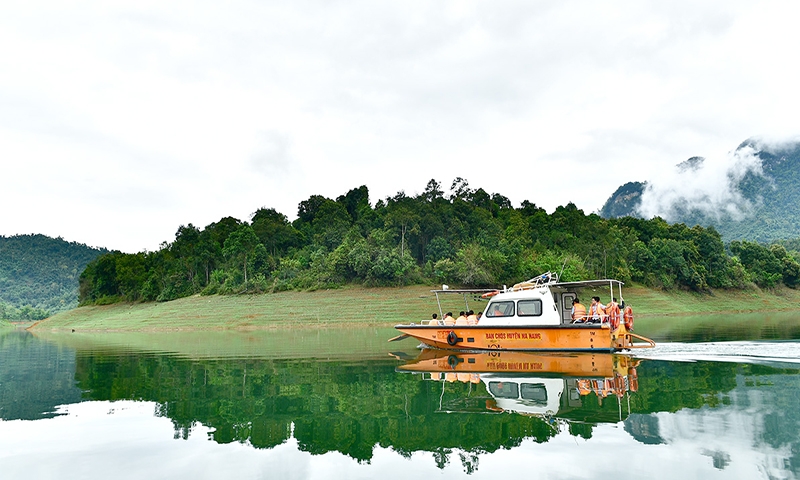
1. OBJECTIVES
* By 2030:
- Average output of exploited wood materials is over 1,300,000 m3/year.
- 100% of wood and wood products use legal wood raw materials.
- Increase from 20% economic value per unit of cultivated area.
- Increase 50% of revenue from community tourism, ecotourism, resort, and entertainment activities compared to 2020; increase 100% by 2050.
- Over 50% of the workforce working in the forestry sector are ethnic minorities living in forested areas.
- From 40% of workers in the forestry sector are trained, trained and given technical guidance; 70% by 2050.
- Sustainable development, enhancing the value of non-timber forest products and sustainable medicinal herbs along the value chain.
- Develop an effective and sustainable form of agricultural, forestry and fishery production organization based on exploiting the potential and advantages of each area in the province.
- Developing forest environmental services; effectively manage and use resources from forest environmental services.
- Effectively deploy forest carbon absorption and storage services and reduce greenhouse gas emissions.
2. TASKS
- Develop legal sources of wood materials and increase value for the wood processing industry:
+ Develop large timber forests, converting from small timber plantations to large timber plantations in: Son Duong, Yen Son, Ham Yen, Chiem Hoa and Tuyen Quang city.
+ Integrate raw material production areas with centralized goods processing.
+ Application of fine processing and deep processing technology; Utilize waste by-products in wood processing.
- Development of non-timber forest products and medicinal materials.
+ Investigate, evaluate and develop non-timber forest products and medicinal plants under the forest canopy.
+ Develop facilities and factories for processing commercial products associated with concentrated raw material production along the value chain.
+ Research, test, select and create varieties and species of non-timber forest products and medicinal plants with high productivity and quality.
+ Forming a concentrated production area for non-timber forest products and medicinal materials.
- Develop combined forms of agriculture, forestry and fishery.
+ Cooperation and production links between businesses, organizations, households, individuals and communities.
+ Select high-value plant and animal species.
+ Apply effective cultivation and quality management measures for crops, livestock, aquatic products combined under the forest canopy.
- Developing forest environmental services.
+ Diversify and expand revenue sources from various types of forest environmental services in accordance with legal regulations.
+ Manage, guide, inspect and supervise to improve the efficiency of using revenue from forest environmental services.
- Develop eco-tourism, resort and entertainment.
+ Strengthen cooperation between forest owners and local communities in the process of planning, managing tourism, and providing tourism products and services
+ Develop typical tourism types and products associated with natural landscape values such as Tan Trao, Na Hang, Lam Binh, Cham Chu, etc.
+ Develop eco-tourism models associated with agricultural, rural and community tourism types.
3. SOLUTION
- Implement and integrate mechanisms and policies; Focus on researching, evaluating, advising and proposing the implementation of policy mechanisms in the field of forestry and other related fields.
- Complete legal procedures for forest management and development of raw material areas; Focus on supporting and inviting investment to expand area and develop forests in districts: Ham Yen, Yen Son, Son Duong, etc.
- Applied science and technology; Receiving and transferring forestry and industrial promotion technology contributes to improving the value and production efficiency of the forestry industry.
- Regarding organization and production:
+ Evaluate and summarize models of large timber forest planting, ecotourism, resort and entertainment models.
+ Continue to organize, innovate, develop and improve the efficiency of forestry companies and forest management boards.
+ Build a model of forest co-management and community engagement.
+ Promote the implementation of the OCOP Program, develop agricultural and rural tourism associated with forest ecosystems.
+ Strengthen regional linkages, develop forestry economy associated with ecological region linkages, develop craft villages, invest in infrastructure, especially forestry roads, to comprehensively exploit the values of forests.
- Training, coaching, propaganda and capacity building for functional forces in inspection, control, traceability of forest products, forest owners, residential communities, etc.
- Enhance international access and cooperation; Effective implementation of projects with support from international organizations.
- Organize and implement programs, schemes and projects in accordance with actual conditions in the unit and locality.

Comment
Print